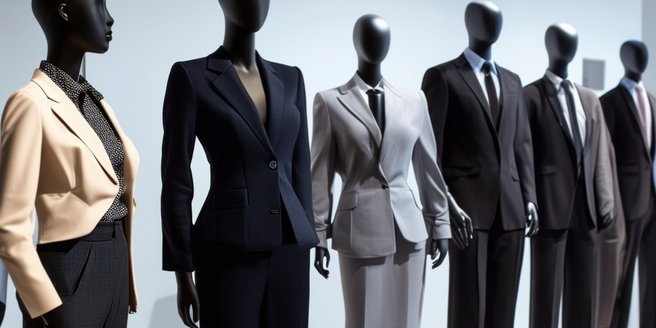
Understanding the Concept of Inclusive Corporate Fashion
Inclusive corporate fashion promotes a crucial change in the apparel industry by advocating for designs and policies that cater to all body types, genders, and physical abilities. This principle transforms traditional norms, fostering real diversity and inclusion in the corporate world. In practice, everyone, regardless of attributes or identity, has equal rights to dress suitably for their roles, prioritizing comfort and self-expression. Rather than restricting clothing by physical characteristics or gender identity, it represents the range of identities within a company. It seeks to alter the rigid view of workplace attire that often solely caters to specific sizes or genders, and insists on equal rights to fashionable and comfortable dress codes at work, challenging fashion entities and corporations to reconsider their attitudes towards workplace attire.
The Importance of Erasing Dressing Barriers in the Workplace
Eliminating restrictive dress code, we foster an inclusive environment where individual differences are valued, enriching our organization. This emphasis on personal authenticity topples archaic ideas about professionalism, curbs discrimination, and eradicates subtle prejudices, thus contributing to a fair workspace. Dress code liberation upholds equality, affirming that merit and skills supersede attire regardless of one’s background or position. Abolition of dressing restrictions is therefore a leap towards a diverse, innovative corporate culture. By celebrating uniqueness, we inspire various thoughts, ideas, and solutions. Such a workspace that respects creativity and champions innovation greatly contributes to a vibrant corporate culture that appreciates diversity.
Current Challenges in Promoting Inclusive Corporate Fashion
Promoting inclusive corporate fashion faces challenges such as overcoming entrenched norms, combating stereotypes, and managing high implementation costs including redesigning uniform guidelines and organizing training. These norms are deeply entrenched in the minds of stakeholders due to societal conditioning that supports certain styles and clothing for specific genders or roles. Therefore, addressing these issues involves redefining ‘appropriate’ workplace fashion.
Although financially intimidating, companies should view these costs as investments that improve their reputation and enhance long-term performance. Overcoming these challenges requires constant education, robust collaboration, and unwavering commitment from all stakeholders. This continuous education aids in changing mindsets and promoting inclusivity, while collaboration enables open dialogue and diverse idea-sharing. Stakeholder commitment, from top leadership to employees, is key in effecting these reforms.
Ultimately, effectively addressed challenges can not only be overcome but also transformed into opportunities, fostering an inclusive corporate culture, improving employee satisfaction, and positively reflecting the company’s values to the outside world.
Successful Corporate Brands Leading the Inclusive Fashion Movement
Top corporate brands are making strides towards initiating and promoting inclusive fashion, designing clothing lines that incorporate accessibility, are void of gender-specific attributes, and encompass a wide range of sizes. Their innovatively crafted collections are not only reshaping the fashion landscape but also making a strong statement about inclusionary practice.
This has led to them creating a new era of fashion that promotes diversity and inclusivity by tackling issues of accessibility, gender norms, and size exclusivity. The fashion lines they’ve created open doors for adaptive, gender-neutral, and size-inclusive options, breaking down barriers that have hindered many from embracing mainstream fashion.
These brands are encouraging others to follow their lead and move towards a more inclusive fashion industry, inspiring establishments to look beyond traditional fashion norms. They reiterate that fashion should be a right and not a privilege, encouraging the global fashion community to follow their transformative path towards a more inclusive industry.
Practical Steps Towards Implementing Inclusive Corporate Dressing
Companies can enhance inclusive dressing by initiating staff consultations to understand diverse needs and cultural, religious, personal preferences, and by developing flexible dress codes to balance individuality and professionalism. It’s beneficial to invest in inclusive fashion by procuring office wear from brands vetted for a variety of body types, genders, and cultural norms, and training proactively about the significance of inclusivity in corporate dressing, potential negatives of cultural insensitivity and unconscious bias. Ensuring support for those who experience backlash due to attire choices is essential in shaping a tolerant workspace that respects individuality while upholding professionalism. These strategies foster a healthier work environment, boosting employee retention, satisfaction, and elevating the organization as a favored employer.
The Future of Inclusive Corporate Fashion: Expectations and Projections
Inclusive corporate fashion is anticipated to flourish significantly in future as more businesses recognize its benefits and implement it in all aspects, particularly fashion. An environment where everyone, regardless of their gender, culture, physique, or personal style, feels represented and comfortable is the aim. Alongside this, an increase in demand for such garments will see the fashion industry work on innovative designs to cater to various body types, skin tones, and personal preferences, ultimately breaking design and functionality barriers.
The evolution towards inclusivity in corporate fashion is expected to foster a more accessible, comfortable and engaging work environment, by offering a greater range of stylish and suitable clothing options. Looking ahead, workplaces may not just accept, but celebrate diversity, doing away with the one-size-fits-all fashion norms. The prospect is that corporate fashion will truly incorporate diversity, building a more inclusive culture that will contribute to an empowering atmosphere where everyone feels valued, thus enrichifying the work environment.
